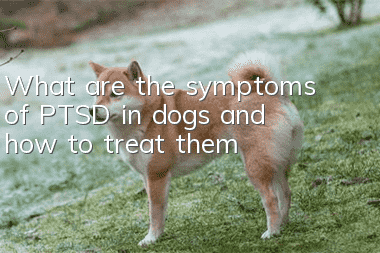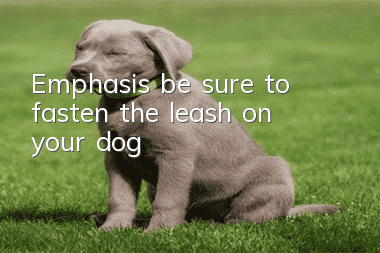What are the symptoms of PTSD in dogs and how to treat them?

At the end of 2016, Ang Lee's "Billy Lynn's Long Halftime Walk" revolutionaryly used 120 frames/4K/3D technology to shoot, telling the story of 19-year-old American soldier Billy Lynn because of his bravery in the Iraq War. Performance, he and his comrades became representatives of American heroes.
He became a hero because of a video of him sacrificing his life to save his captain on the battlefield. That day, in order to save the captain, he fought hand-to-hand with the enemy and finally killed the enemy. Then when he turned around, he saw that the captain, who had been shot long ago, had also died. There is no victory to speak of, everyone is completely defeated.
Billy Lynn said: "Someone comes to praise you for the worst day of your life." Douban film review said, "VR viewing of large-scale PTSD."
Baidu Encyclopedia explains that post-traumatic stress disorder (PTSD) refers to an individual experiencing, witnessing or encountering one or more actual deaths involving themselves or others, or being threatened with death, or being seriously injured, or having their physical integrity compromised. The delayed onset and persistence of a mental disorder in an individual following a threat.
You may have heard that people can suffer from PTSD (posttraumatic stress disorder). When we commemorated Wenchuan in recent years, we began to pay attention to the "aftershocks" in the hearts of those who survived. Xin Shixiang once wrote an article "Nine years later, I still didn't run out | The rest of my life after the earthquake", reminding us that what needs to be reconstructed after the disaster is still the human heart.
While we are paying attention to people’s psychological recovery after disasters, have you ever thought about whether dogs can also suffer from PTSD? When a dog experiences some trauma, it will also suffer from PTSD. He won't develop PTSD because you hit him in the nose while he chewed his pillow, but he may develop PTSD if he experiences the following:
1. Natural disasters, such as hurricanes passing through
2.Abandoned in the wild
3. Lose its owner
4.Military attack
5. Physical or mental abuse
6. A serious accident
7. Vicious battles with other animals (including wars between dogs)
Signs of PTSD in dogs are often difficult to distinguish from other anxiety disorders in dogs, and often go unnoticed. But when they have the following abnormalities, combined with the trauma they have experienced, this may be PTSD:
1. Pee in the house
2. Howling, barking or whining
3. Destructive behavior
Dogs suffering from PTSD are also likely to show signs:
1. Tail between legs
2. Drooped ears
3. Out of breath
4. Crouch on the ground
Other clues your dog may be suffering from PTSD:
1. He clings to you in fear
2. Sudden attack
3.Depression
4. Pay high attention to the surrounding environment.
People suffering from PTSD require psychotherapist intervention, and if a dog has PTSD, any history you know about his adverse experiences can help your veterinarian make the correct diagnosis.
A type of behavioral training called total body desensitization, common for dogs with PTSD, involves exposing your dog to anything that makes it anxious or fearful. For example, if noise is a trigger, desensitization treatment can be performed by using noise and food at the same time. When your dog is calm enough to hear the noise, offer him a treat. As long as he stays calm, the noise slowly gets louder and the food keeps flowing. After many matches like this, the dog will associate the noise with food instead of fear.
This is also the purpose of full-body desensitization therapy, so that your dog associates the trigger with the treatment, rather than the trauma.
Other important parts of PTSD treatment include daily exercise, play, and positive reinforcement training.
Training may take weeks or years. It may not cure PTSD, but it can help your dog live a healthy and happy life as long as you limit his exposure to things that trigger his stress.
However, do you still remember the story shared by pet behavior trainer Ning Wei before? That border collie was beaten for improper defecation in the kennel all year round, so that it was extremely resistant to defecation behavior and would even take the initiative to eat everything in front of it. This is a typical case of dogs suffering from PTSD. Ning Wei also used desensitization treatment on it, using sausages to guide it to stop eating feces. We all know the results of the experiment. The dog actually learned that only when Ning Wei was present, it stopped eating feces. Under the circumstances, it still eats it correctly.
The intervention of the desensitization experiment is essentially a kind of guided remediation. Those unpleasant experiences in childhood will leave a lifelong mark on the dog, which may be irreparable.
However, when searching for relevant information on "How to treat dogs suffering from PTSD", we found that apart from desensitization treatment, there were almost no other treatment methods. We tried to find ways to learn from the methods of treating PTSD in humans. Treating PTSD in dogs. But we unfortunately found that in the treatment of PTSD in humans,, the most mentioned keyword is "telling", this method is also very common in other human psychological treatments.
However, there is no common language system between us and dogs, so we cannot accurately perceive each other. The only thing we can do is to prevent dogs from associating the world with fearful things through patient desensitization treatment and emotional communication. stand up.
In addition to PTSD, dogs’ psychological problems are also often ignored. Now that we are hearing more about depression in dogs, we should be aware that even dogs that have not experienced severe trauma can have fears that cause anxiety or aggression. Some of the most common are:
1.Thunder
2. Fire
3.Children
4. Men
5. Take a car
6. Go downstairs
7. Shadow
Some dogs are naturally fearful, but most are fearful because of something they experienced as a child or something that didn't happen to them. It could be living in a storm, or it could just be a lack of human contact. Although a dog does not have PTSD, it does not mean that its behavior is not difficult for the owner to control and is not potentially dangerous to other people.
So the dog’s fear needs to be managed. What do you do once your dog starts acting fearful or aggressive? This is not the same as how you would treat a child. You don't offer comfort, such as reassurances or kisses. These things don't let your dog know that everything is going to be okay, rather, these behaviors teach it that it's okay to act fearful or aggressive, and it won't change because it feels like it's right.
The easiest way to overcome a dog's fear and anxiety is to divert his attention and do something else with him. If he's barking at your household staff, calmly clip the leash and start practicing commanding him with treats.
What needs to be remembered is that you are the dog's owner. Your actions teach your dog when to worry and when not to worry. While you are responsible for your dog, you must also be responsible for its fear.
- golden retriever genetic disease
- How to train the ferocity of a Rottweiler? How to train a Rottweiler!
- Prevention and care of dog diseases
- The fastest way to treat eczema in dogs
- Symptoms of dog poisoning
- What are the consequences of dogs drinking beer?
- How to train a Pomeranian to shake hands? Pomeranian life training guide!
- Dogs always like to be close to people. What should I do if they are too clingy to their owners?
- Causes of ovarian cysts in dogs | Diagnosis | Prevention and treatment methods
- Signs of fatal disease in dogs



